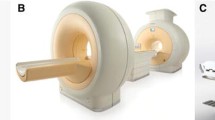Abstract
A new method of analysing the data available from routine 81 m Kr equilibrium inhalation investigations has been developed. The data for analysis are acquired from a gamma camera in the form of a sequential series of images from which multiple breath activity-time curves are generated for eight regions in the lung. The method is based on a description of the behaviour of the radioactive gas in the lung using a mathematical model. Values of specific mean expiratory gas flow, that is mean expiratory gas flow per unit lung volume, are calculated from the application of the model to the expiratory phase only of a single breath activity-time curve which is generated from the multiple breath activity-time curve using post-acquisition gating. This method overcomes the problem of non-uniform inspiratory concentration of tracer gas experienced in previously reported techniques of analysing inhalation data obtained using poorly soluble radioactive gases. The model is shown, in simulation studies, to be an adequate description of the behaviour of radioactive gas in the lung and the analysis technique is shown, in clinical studies, to be both reproducible and sensitive to disease state.
Similar content being viewed by others
References
Alpert NM, McKusick KA, Correin JA, Shea W, Brownwell GL, Potsaid MS (1975) Initial assessment of a simple functional image of ventilation. J Nucl Med 17:88–92
Arnot RN, Clark JC, Herring AN, Chakrabarti MK, Sykes MK (1981) Measurement of regional ventilation using nitrogen-13 and krypton-81 m in mechanically ventilated dogs. Clin Phys Physiol Meas 2:183–197
Arnot RN, Sykes MK, Clark JC, Herring AN, Chakrabarti K, Buranapong P (1978) Measurement of total lung ventilation in anaesthetized dogs using krypton 81 m and nitrogen 13. In: Lavender JP (ed) Clinical and experimental applications of krypton 81 m. Br J Radiol Special Report 15:69–82
Bajzer Z, Nosil J (1977) A simple mathematical lung model for quantitative regional ventilation measurement using Kr-81 m. Phys Med Biol 22:975–980
Bajzer Z, Nosil J (1980) Lung ventilation model for radioactive tracer tidal breathing. Phys. Med Biol 25:293–307
Chatfield C (1975) Statistics for technology. Chapman and Hall, London
Ciofetta G, Silverman M, Hughes JMB (1980) Quantitative approach to the study of regional lung function in children using krypton-81 m. Br J Radiol 53:950–959
Fazio F, Jones T (1975) Assessment of regional ventilation by continuous inhalation of radioactive krypton-81 m. Br Med J 3:673–676
Grenvik A, Hedstrand U, Sjogren h (1966) Problems in pneumotachography. Acta Anaestesiol Scand 10:147–155
Lamb JF, Baker GA, Goris ML, Khentigan A, Moore HA, Neesan WC, Winchell HS (1978) Production and clinical evaluation of a commercial krypton 81 m gas generator and its delivery system. In: Lavender JP (ed) Clinical and experimental applications of krypton 81 m. Br J Radiol Special Report 15:22–32
Miller JM, Khalil Ali M, Howe CD (1970) Clinical determination of regional pulmonary function during normal breathing using xenon-133. Am Rev Resp Dis 101:218–229
Modell HI, Graham MM (1982) Limitations of Kr-81 m for quantitation of ventilation scans. J Nucl Med 23:301–305
Nosil J, Bajzer Z, Spaventi S (1977) The use of Kr-81 m gas for the measurement of absolute regional lung ventilation. Nuklearmedizin 16:13–17
Rosenzweig DY, Hughes JMB, Jones T (1969) Uneven ventilation within and between regions of the normal lung measured with nitrogen-13. Resp. Physiol 8:86–97
Secker-Walker RH, Alderson PO, Wilhelm J, Hill RL, Markham J, Baker J, Potchen EJ (1975) The measurement of regional ventilation during tidal breathing: a comparison of two methods in healthy subjects, and patients with chronic obstructive lung disease. Br J Radiol 48:181–189
Spaventi S, Nosil J, Bajzer Z, Pardon R (1978) Clinical and experimental applications of a new mathematical lung model for krypton 81 m inhalation. In: Lavender JP (ed) Clinical and experimental applications of krypton-81m. Br J Radiol Special Report 15:60–68
Touya JJ, Jones JP, Patton JJ, Erickson JJ, Rollo FD, Price RR (1981) Ventilation/perfusion ratio images by gated regional spirometry. In: Esser PD (ed) Functional mapping of organ systems and other computer topics. The Society of Nuclear Medicine, New York. pp 31–37
West JB (1977) Regional differences in the lungs. Academic Press, New York
Winlove CP, Freedman N, Godfrey S (1975) The quantitation of regional lung function in infants and young children. Preprint: Hammersmith Hospital, London
Author information
Authors and Affiliations
Rights and permissions
About this article
Cite this article
Hamilton, D., Godfrey, K.R., Causer, D.A. et al. Regional specific mean expiratory gas flow from 81mKr equilibrium inhalation data. Eur J Nucl Med 10, 321–331 (1985). https://doi.org/10.1007/BF00251305
Received:
Accepted:
Issue Date:
DOI: https://doi.org/10.1007/BF00251305




